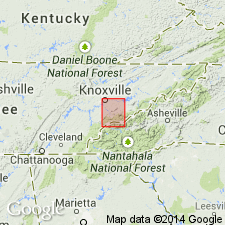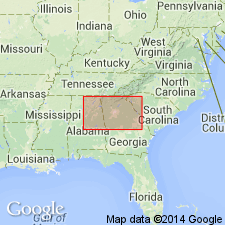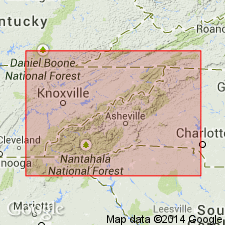
- Usage in publication:
-
- Nichols shale*
- Modifications:
-
- Original reference
- Dominant lithology:
-
- Shale
- AAPG geologic province:
-
- Piedmont-Blue Ridge province
Summary:
Pg. 3. Nichols shale. Grayish-blue shales, sandy, micaceous, argillaceous, and slightly calcareous; of uniform composition throughout. Thickness 550 to 800 feet. Overlies Cochran conglomerate. Underlies Nebo sandstone. Age is Early Cambrian.
Source: US geologic names lexicon (USGS Bull. 896, p. 1497).

- Usage in publication:
-
- Nichols slate*
- Modifications:
-
- Overview
- AAPG geologic province:
-
- Piedmont-Blue Ridge province
Summary:
[Current (ca. 1936) adopted usage of the USGS]. Nichols slate of Chilhowee group. Age is Early Cambrian.
Named from Nichols Branch of Walden Creek, at east end of Chilhowee Mountain, Sevier Co., eastern TN. Extends into western NC.
Source: US geologic names lexicon (USGS Bull. 896, p. 1497).

- Usage in publication:
-
- Nichols Formation*
- Modifications:
-
- Revised
- AAPG geologic province:
-
- Piedmont-Blue Ridge province
Summary:
The Nichols Formation of the Chilhowee Group in the Bill Arp and Rome thrust sheets in GA and AL overlies the Cochran Formation and underlies the Wilson Ridge Formation. Age is Early Cambrian.
Source: GNU records (USGS DDS-6; Reston GNULEX).

- Usage in publication:
-
- Nichols Formation
- Modifications:
-
- Biostratigraphic dating
- AAPG geologic province:
-
- Appalachian basin
Summary:
Age constraints for the Vendian to Placentian Chilhowee Group are provided by, 1) the occurrence of Vendian acritarchs in the subjacent Sandsuck, Wilhite, and Shields Formations; 2) the first occurrence of PALAEOPHYCUS traces in the basal Cochran and Unicoi Formations; 3) the first occurrences of SKOLOTHOS and PLANOLITES traces in the overlying Nichols and Hampton Formations; 4) the abundance of well-developed arthropod as well as other diagnostic traces in the uppermost Nebo and overlying Murray Formations; 5) the recalculated age of 539 +/-30 Ma for the Murray Formation; and 6) reported occurrences of late Placentian or younger body fossils recovered from the Murray Shale, including trilobites, ostracodes, inarticulate brachiopods, hylithoids, and acritarchs. The sequence in the Cochran-Unicoi interval where the Precambrian-Cambrian boundary is interpreted to occur consists of coarse-grained braided-fluvial sediments. It may prove impossible to locate the boundary precisely because of a lack of marine facies, and the shelly microfossils it might have provided.
Source: GNU records (USGS DDS-6; Reston GNULEX).
For more information, please contact Nancy Stamm, Geologic Names Committee Secretary.
Asterisk (*) indicates published by U.S. Geological Survey authors.
"No current usage" (†) implies that a name has been abandoned or has fallen into disuse. Former usage and, if known, replacement name given in parentheses ( ).
Slash (/) indicates name conflicts with nomenclatural guidelines (CSN, 1933; ACSN, 1961, 1970; NACSN, 1983, 2005, 2021). May be explained within brackets ([ ]).

